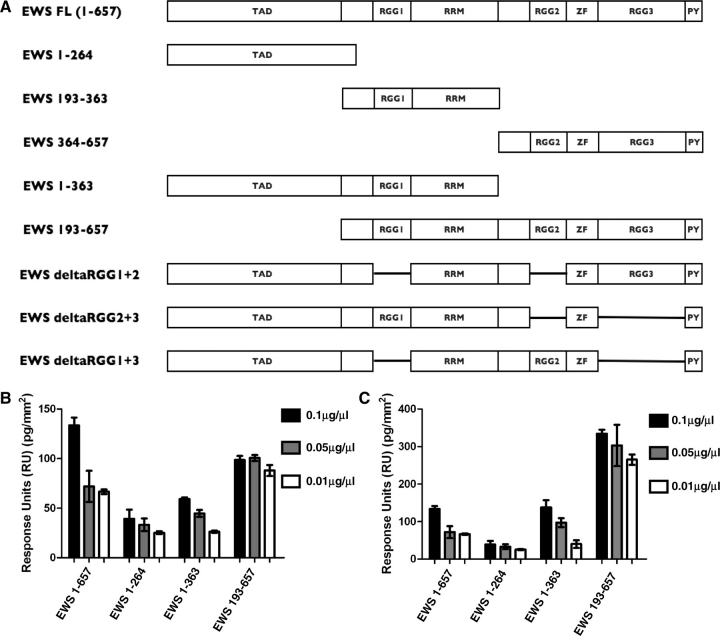Fig. 2.
EWS-derived proteins containing one or more RGG motifs interact directly with SMN. (A) Schematic diagram of EWS panel constructs labelled by amino acid numbers. The transactivation domain (TAD), the arginine-glycine rich (RGG) motifs (RGG1, RGG2 and RGG3), the zinc-finger motif (ZF) and the C-terminal nuclear localization signal (PY) are all shown. The panel consists of the following constructs: (i) EWS full-length (EWS FL; 1–657); (ii) EWS amino acids 1–264 (EWS 1–264); (iii) EWS amino acid 193–363 (EWS 193–363); (iv) EWS amino acids 364–657 (EWS 364–657); (v) EWS amino acids 1–363 (EWS 1–363); (vi) EWS amino acids 193–657 (EWS 193–657); (vii) EWS delta RGG1 and RGG2 (EWS delta RGG1+2); (viii) EWS delta RGG2 and RGG3 (EWS delta RGG2+3); and (ix) EWS delta RGG1 and RGG3 (EWS delta RGG1+3). (B and C) BA-SMN was immobilized on a SA-Biacore chip, and pulsed with EWS 1–657 (containing RGG1, 2 and 3); EWS 1–363 (containing RGG 1); EWS 193–657 (RGG1, 2 and 3), and EWS 1–264 (no RGG-domains; negative control). (A) A bar graph comparing the binding values for 1–657, 1–363, 193–657 and 1–264 on the SMN chip. Protein binding is represented as response units (RU), with one RU representing 1 pg/mm2 of protein binding to the chip surface. The error bars show the standard deviation (SD) between the three repeats. (B) BA-SMN was immobilized on a SA-Biacore chip, and pulsed with EWS 1–657 (containing RGG1, 2 and 3); EWS 1–264 (containing no RGG domains); EWS 193–363 (containing RGG1) and EWS 364–657 (containing RGG2 and 3). Protein binding is represented as RU, with one RU representing 1 pg/mm2 of protein binding to the chip surface. The error bars show the SD between the three repeats. At a protein concentration of 0.1 µg/µl EWS 1–657, EWS 193–363 and EWS 364–657 all bind significantly greater than EWS 1–264 with a P < 0.001. (D) Sample sensorgrams for the binding of EWS 1–264 (top panel) and EWS 364–657 (bottom panel) to the BA-SMN chip. The traces show the real-time binding of both proteins to the BA-SMN chip in response units (pg/mm2). Binding experiments were repeated three times and the sensorgrams for all three runs are overlaid and presented.


